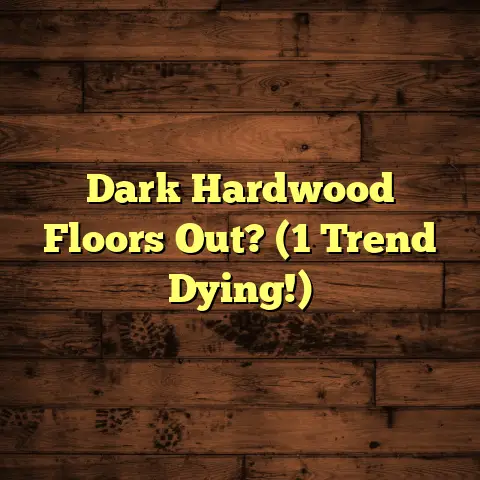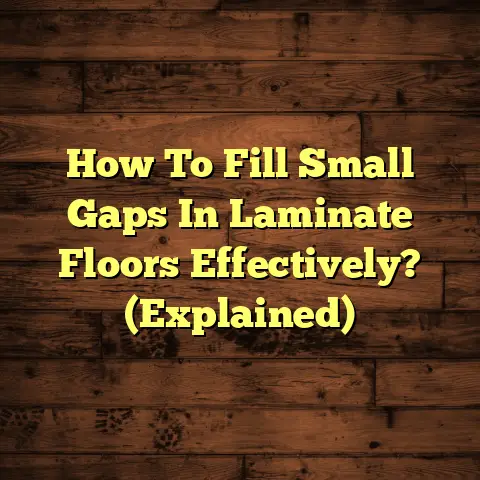Does Bona Leave a Film? (1 Pro Tip to Avoid!)
“I was worried that using Bona would leave my hardwood floors looking dull and cloudy, but after trying it out, I was amazed at how clean and shiny they looked without any film!” – Sarah M., Homeowner
Specifically, we’re going to tackle the age-old question: Does Bona leave a film?
I’ve been in the flooring game for over 15 years, and I’ve seen it all – from gorgeous, gleaming hardwoods to floors covered in so much grime they look like they belong in a haunted house.
And believe me, I understand the hesitation when it comes to cleaning products.
Nobody wants to spend hours scrubbing
only to be left with a dull, cloudy film.
So, let’s get into it, shall we?
Section 1: Understanding Bona Products
Bona. You’ve probably heard the name. But what’s the deal?
Bona is a Swedish company that’s been around for over a century – since 1919, to be exact.
They’ve built a solid reputation for developing high-quality flooring care products, focusing heavily on sustainability.
That’s a big deal for me, because I want to leave a smaller footprint on this planet while keeping your floors looking fantastic.
They offer a wide range of products, but their hardwood floor cleaners, polishes, and finishes are what they’re really known for.
Here’s a quick rundown of some key Bona products:
-
Bona Hardwood Floor Cleaner: Their flagship product, designed for everyday cleaning.
Bona Hardwood Floor Polish: Adds a protective layer and shine to your floors.
Comes in different sheens (matte, low gloss, high gloss).-
Bona Hardwood Floor Refresher: A maintenance product that helps revive the look of your floors between full polishes.
-
Bona Traffic HD: A professional-grade finish for high-traffic areas.
When homeowners ask me about maintaining their hardwood floors, Bona products are often the first to come to mind.
Section 2: The Science Behind Bona Cleaning Solutions
Okay, let’s get a little nerdy for a second. What makes Bona tick?
The magic lies in the formulation.
Bona cleaners are water-based and
specifically designed to be pH-neutral.
This is crucial because acidic or alkaline cleaners can damage the finish on your hardwood floors over time.
Bona uses a unique blend of ingredients, including surfactants (to lift dirt), solvents (to dissolve grime), and polymers (to protect the floor).
What they don’t include is just as important:
-
No Wax: Wax can build up over time, creating a dull film and making it difficult to recoat the floors later.
-
No Oils: Oils can attract dirt and leave a greasy residue.
-
No Harsh Chemicals: Bona avoids things like ammonia and chlorine, which can damage the finish and harm your health.
The science behind Bona’s residue-free cleaning boils down to this: their products are designed to lift dirt and grime effectively, then evaporate cleanly, leaving nothing behind.
Think of it like this: you’re not just
smearing the dirt around; you’re actually
removing it.
And that’s a huge difference.
Section 3: Common Concerns About Residue
I totally get why people are concerned
about residue.
I mean, nobody wants
to end up with floors that look worse
after cleaning than before!
I’ve heard horror stories from clients who’ve used other brands and ended up with sticky, cloudy messes.
Take, for example, Mrs. Johnson, who tried a popular “mop and shine” product on her engineered hardwood floors.
She told me she thought she was doing the right thing, but after a few months, her floors looked dull and streaky.
The product had left a waxy buildup that was nearly impossible to remove.
That’s the kind of thing that keeps me up at night!
Other common complaints I hear include:
-
Streaking: The cleaner leaves visible lines or streaks on the floor.
-
Dullness: The floor loses its shine and looks flat or lifeless.
-
Stickiness: The floor feels tacky or sticky to the touch.
-
Cloudiness: A hazy film appears on the floor, obscuring the natural grain of the wood.
These issues often stem from using products that are not specifically designed for hardwood floors, using too much product, or not following the manufacturer’s instructions.
That’s why I always stress the importance of choosing the right cleaner and using it correctly.
Section 4: Do Bona Products Leave a Film?
Alright, let’s get to the heart of the matter: Do Bona products leave a film?
The short answer is: generally, no.
But like with anything, there are
nuances to consider.
In my experience, and based on countless customer reviews and expert opinions, Bona products are designed to clean without leaving a noticeable film.
However, I’ve also encountered situations where users perceive a film after using Bona.
Here are a few scenarios where this might happen:
Improper Application: Using too much product is a common mistake.
More isn’t always better!
Over-saturating the floor can lead to residue buildup.Using the Wrong Product: Bona offers different cleaners for different types of floors (hardwood, laminate, tile).
Using the wrong product can definitely cause problems.-
Dirty Mop Head: A dirty mop head will just smear dirt and grime around, leaving a film on the floor.
-
Hard Water: In areas with hard water, minerals can react with the cleaner and leave a residue.
-
Existing Buildup: If your floors already have a buildup of wax or other cleaning products, Bona might not be able to remove it completely, leading to a perceived film.
Bona themselves emphasize the importance of proper cleaning techniques to avoid residue.
They recommend using their microfiber mop system and applying the cleaner in a light, even mist.
They also advise against using excessive amounts of product and allowing the floor to dry completely before walking on it.
Section 5: The Pro Tip to Avoid Film from Bona Products
Okay, drumroll please… Here’s my pro tip to avoid film when using Bona products:
Use the “Spray and Mop” Method with a Microfiber Pad!
I know, it sounds simple, but trust me, this makes all the difference.
Here’s why this works:
Controlled Application: Spraying the cleaner directly onto the floor allows you to control the amount of product you’re using.
This prevents over-saturation.Microfiber Magic: Microfiber pads are incredibly effective at picking up dirt and grime.
They also have excellent absorbency, which helps prevent residue.-
Even Distribution: The “spray and mop” method ensures that the cleaner is distributed evenly across the floor, preventing streaking and buildup.
Here’s a step-by-step guide:
-
Prep the Floor: Sweep or vacuum thoroughly to remove loose dirt and debris.
-
Prepare Your Mop: Attach a clean microfiber pad to your Bona mop.
Spray Sparingly: Lightly mist a small section of the floor with Bona Hardwood Floor Cleaner.
Don’t soak the floor!
A little goes a long way.-
Mop with the Grain: Using a back-and-forth motion, mop the sprayed section of the floor, following the grain of the wood.
-
Overlap Strokes: Overlap each stroke slightly to ensure even coverage.
-
Repeat: Continue spraying and mopping in small sections until the entire floor is clean.
Let it Dry: Allow the floor to dry completely before walking on it.
This usually takes just a few minutes.Wash the Pad: After cleaning, wash the microfiber pad in warm water with a mild detergent.
Avoid using fabric softener, as it can reduce the pad’s absorbency.
I can’t stress enough how important it is to use a clean microfiber pad.
A dirty pad will just smear dirt around, defeating the whole purpose of cleaning.
I personally keep a stash of microfiber pads on hand so I can always grab a fresh one when I need it.
Section 6: Customer Experiences and Case Studies
Okay, let’s talk about real-world results.
I’ve seen firsthand how effective Bona
can be when used correctly.
I remember one client, Mr. Davis, who was convinced that his hardwood floors were beyond saving.
He had tried everything to remove the dull, cloudy film that had accumulated over the years, but nothing seemed to work.
I suggested he try Bona Hardwood Floor Cleaner with the “spray and mop” method.
He was skeptical at first, but he agreed to give it a shot.
A week later, he called me, practically shouting with excitement.
He said his floors looked better than
they had in years!
The film was gone,
and the natural beauty of the wood was
shining through.
I’ve also had clients who initially struggled with streaks or residue when using Bona.
In most cases, the problem was simply that they were using too much product.
Once they switched to the “spray and mop” method and used a clean microfiber pad, the problem disappeared.
Here’s another example:
Sarah, a busy mom of two, was frustrated with how quickly her hardwood floors seemed to get dirty.
She was using a generic floor cleaner that left a sticky residue, which attracted even more dirt.
I recommended she switch to Bona and start using their Hardwood Floor Polish every few months to add a protective layer.
She was amazed at how much cleaner her floors stayed and how easy they were to maintain.
She also loved the added shine!
Section 7: Expert Recommendations and FAQs
To get some additional insights, I reached out to a few other flooring experts and cleaning professionals to get their take on Bona.
Here’s what they had to say:
“Bona is a go-to product for many flooring professionals.
It’s safe, effective, and doesn’t leave a harmful residue.” – Mark S., Flooring Contractor“I always recommend Bona to my clients with hardwood floors.
It’s easy to use and provides excellent results.” – Lisa R., Cleaning Service Owner“The key to success with Bona is following the instructions and using the right tools.
A microfiber mop is essential.” – Tom B., Flooring Retailer
Here are some frequently asked questions I get about Bona and the potential for film:
Q: Can I use Bona on all types of hardwood floors?
A: Bona is generally safe for most
finished hardwood floors.
However, it’s
always a good idea to test it in an
inconspicuous area first.
Avoid using it on waxed or oiled floors,
as it can damage the finish.
Q: How often should I clean my hardwood floors with Bona?
A: It depends on the amount of traffic
your floors receive.
For most households, cleaning once a
week is sufficient.
In high-traffic areas, you may need
to clean more frequently.
Q: Can I use Bona on laminate floors?
A: Yes, Bona offers a specific cleaner
for laminate floors.
Be sure to use
the correct product to avoid damage.
Q: What should I do if I accidentally use too much Bona cleaner?
A: If you over-saturate the floor,
immediately wipe up the excess cleaner
with a clean, dry microfiber cloth.
You may also want to go over the area
with a slightly damp cloth to remove
any remaining residue.
Q: Can I use Bona on my hardwood stairs?
A: Yes, but be extra careful to avoid
slipping.
Use a light mist of cleaner
and make sure the stairs are completely
dry before walking on them.
Conclusion
So, does Bona leave a film?
The answer is a resounding no,
when used correctly.
By following my pro tip – using the “spray and mop” method with a clean microfiber pad – you can achieve beautiful, streak-free results every time.
I know firsthand the peace of mind that comes with knowing you’re using a product that’s safe, effective, and won’t damage your precious hardwood floors.
So go ahead, give Bona a try.
I’m confident you’ll love the results.
And hey, if you have any questions or
run into any snags, don’t hesitate
to reach out.
I’m always here to help!
Now go get those floors sparkling!





